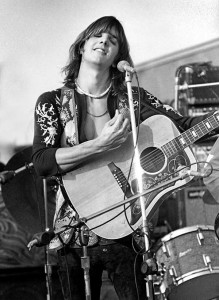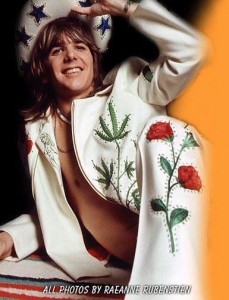Woulda, coulda, shoulda. That was the story of Gram’s life. He’d have turned 70 today, and might have accomplished a whole lot of things had he not checked out (chemically, permanently) in room #8 of the Joshua Tree Inn on September 19, 1973.
I’ve written a lot about the man and his music through the years. Now, just how many more new aspects of Gram can I force feed you?
Let’s take a look at some of his few existing filmed performances, starting with an all-too-short appearance in “The Trip,” a 1967 counter-culture movie directed by Roger Corman. It includes several scenes that feature Gram performing with one of his early groups, The International Submarine Band. It’s hard to catch Gram in action in this clip, because the scenes are short and the editing is fast. But you can see him in the early scene wearing a striped shirt, standing in the middle of the other band members, way in the background. In the party scene he’s wearing a red jacket, high-neck white shirt and sunglasses. He always stands out in a crowd.
Gram wrote the song “Lazy Days” for this film, but Corman felt it wasn’t psychedelic enough for this acid hippie flick. So he kept the scenes of the band lip-syncing and guitar-syncing and replaced the music with a track by the band Electric Flag (listed in credits as The American Music Band). There’s no credit in the film for Gram or the Sub Band. The movie stars Peter Fonda and Bruce Dern and was written by Jack Nicholson.
Gram gets some real face-time at last, flirting and flaunting for the camera in this 1969 video with The Flying Burrito Brothers, the group he co-founded with Chris Hillman in 1968. “Christine’s Tune” is one of the group’s best and most popular songs. He co-wrote it with Hillman (who shares lead vocals) about Christine Hinton, a one-time girlfriend of David Crosby’s. When Christine was killed in a freak car accident shortly after this song was recorded it became known as “Devil in Disguise.” The boys were all decked out in their famous “Nudie Suits” for this performance. But look closely at Gram’s ensemble, embellished with flames, poppies, multi-colored pills, marijuana leaves, crucifixes, and nude women. Of all the outfits designed by Nudie Cohn’s Rodeo Tailors, Gram’s costume is considered the most spectacular of all.
Finally, by 1970, Gram is ready for his close-up, hamming it up as a swinging yachtsman in this video for the Burritos’ “Older Guys.” He had been hanging out with the Rolling Stones quite a bit during this period of his career, forging a drug-fueled, brother-like relationship with Keith Richards. But clearly it was Mick he was shamelessly copying in this video: hands on his skinny hips, scarf around his neck, strutting around with barely a trace of undies beneath his little white pants. Legend has it that some of Gram’s Burrito Brothers hated the way he shimmied and strolled in this performance.
Had Gram lived, would he have wanted to try his hand at acting, as many of contemporaries did at one time or another? Mick Jagger, Roger Daltrey, David Bowie, Tom Waits, and Bob Dylan all took their turns on the big screen. Well, we’ll never know. But one thing’s for sure: his topsy-turvy life and bizarre desert DIY post-mortem would make for one damn compelling “truth is stranger than fiction” film.
Here’s “Lazy Days,” the rejected song Gram wrote for “The Trip.” It later appeared on the Flying Burrito Brothers’ “Burrito Deluxe” LP.
© Dana Spiardi, Nov 5, 2014
Click here to help induct Gram in to the Country Music Hall of Fame.
]]> Gram’s early life was full of all the sordid ingredients that make for a classic southern gothic melodrama. Born into a filthy rich family on November 5, 1946, Ingram Cecil Connor III would lose both parents while still a teen. When Gram was 12 his alcoholic father committed suicide at the family home in Waycross, Georgia. Soon after, his mother – heiress to a Florida citrus empire – married a philanderer named Robert Parsons, who adopted Gram and his younger sister Avis. On the day Gram graduated from high school his alcoholic mother died from cirrhosis of the liver. Bob Parsons wound up marrying the household babysitter and putting young Avis in a mental institution. Gram ended up with a large trust fund that would sustain him financially for the rest of his life. He headed to Harvard, dropped out after one semester, and soon hooked up with musicians who helped crystallize his musical ambitions.
Gram’s early life was full of all the sordid ingredients that make for a classic southern gothic melodrama. Born into a filthy rich family on November 5, 1946, Ingram Cecil Connor III would lose both parents while still a teen. When Gram was 12 his alcoholic father committed suicide at the family home in Waycross, Georgia. Soon after, his mother – heiress to a Florida citrus empire – married a philanderer named Robert Parsons, who adopted Gram and his younger sister Avis. On the day Gram graduated from high school his alcoholic mother died from cirrhosis of the liver. Bob Parsons wound up marrying the household babysitter and putting young Avis in a mental institution. Gram ended up with a large trust fund that would sustain him financially for the rest of his life. He headed to Harvard, dropped out after one semester, and soon hooked up with musicians who helped crystallize his musical ambitions.
This early history is crucial, because it sheds light on how and why Gram turned out the way he did – and how he ended up writing some of the most heartbreaking songs in history. But I’ll stop here with the biographical details. There is plenty of juicy Gram lore on the Internet. All of his major personal and professional highs and lows are well documented: his hasty flight from the Byrds on the eve of a tour of apartheid South Africa; his high-output days with Chris Hillman in the early Flying Burrito Brothers; his exchange of musical knowledge, pharmaceuticals and heroin cures with brother-figure Keith Richards; his often erratic drug- and alcohol-fueled performances; his brilliant collaborations with Emmylou; his sad death from morphine and booze in Room 8 of the low-rent Joshua Tree Inn just as his solo career was taking off.
And then there’s the grandaddy of all Gram legends: the kidnapping and DIY cremation of his body in Joshua Tree National Park by his inebriated, ex-con road manager Phil Kaufman – a tale so twisted it became the basis for the moronic movie Grand Theft Parsons. This stunt, coupled with the poor-little-rich-boy saga of his early years and the high-lonesome style of his life and music, have elevated Gram Parsons to mythic status.
Like so many others who died young from misadventure, Gram has been analyzed, scrutinized and lionized by countless music historians. He’s described by all who knew him as winsome, magnetic, well-mannered, passionate, generous, visionary, even “cuddly” (yes, fellow Burrito Chris Hillman said that). One of my favorite quotes is from the superb music writer Stanley Booth, who said, “Gram was in his way a pure soul, pure and driven as the driven snow. When I met him, he looked like a green-eyed Palomino pony.”
Yet, he’s described by many of the same people as irresponsible, flighty, self-centered, spoiled, attention-hungry, musically careless, even fatalistic – destined to follow the path of his self-destructive parents. Manuel Cuevas, the Nudie’s Rodeo Costumes tailor who created some of the world’s most spectacular stage wear, speculates that Gram was predicting his manner of death when he asked him to embroider flames, poppies, multi-colored pills, marijuana leaves, a crucifix and nude women onto the famous suit he was so often photographed wearing.
In the end, what’s most important is Gram Parsons’ contributions to the world of music. One of things that most impresses me was his unflinching devotion to turning the world on to the beauty and honesty of the country sound and its natural role in what he referred to as Cosmic American Music. Tales of Gram jumping onto his motorcycle to race off and buy George Jones and Merle Haggard records to play for his country-illiterate friends are legendary.
 Promoting and performing country music the way he did during the height of the psychedelic, protest-era 1960s was a gutsy thing to do. His efforts offended many country purists and turned off just as many rock fans. Singing onstage in hardcore cowboy clubs wearing flamboyant, sometimes effeminate, country-western clothing took a lot of confidence (and he had it in spades). Many argue that Gram didn’t invent country rock (a genre term he hated, by the way). Others were injecting twang into modern music years before he came along. But it was this groovy, gorgeous, long-haired Harvard dropout who made country COOL. By the mid-1970s there would be a glut of soulless country rock acts. The music became mainstream, boring, and just plain commercial.
Promoting and performing country music the way he did during the height of the psychedelic, protest-era 1960s was a gutsy thing to do. His efforts offended many country purists and turned off just as many rock fans. Singing onstage in hardcore cowboy clubs wearing flamboyant, sometimes effeminate, country-western clothing took a lot of confidence (and he had it in spades). Many argue that Gram didn’t invent country rock (a genre term he hated, by the way). Others were injecting twang into modern music years before he came along. But it was this groovy, gorgeous, long-haired Harvard dropout who made country COOL. By the mid-1970s there would be a glut of soulless country rock acts. The music became mainstream, boring, and just plain commercial.
If you’re a Gram devotee, you dig what I’m saying. If you’re new to all this, go to the Internet and sample his songs. Watch some of the few available videos of his performances on YouTube. Check out his early work with the International Submarine Band, the Byrds and the Flying Burrito Brothers. Pay close attention to two of his masterpieces: “Hickory Wind” and “Hot Burrito #1.” And don’t overlook his final solo albums – “GP” and “Grievous Angel” – which feature his brilliant harmonies with the ethereal Emmylou Harris, who today is Gram’s biggest champion.
Some of these sounds will make you swing and some will make you sad. But that’s okay. Who doesn’t love a deliciously melancholy tears-in-your-beer heartache song? When I hear Gram, with his alcohol-marred, high-lonesome voice harmonizing with Emmylou on the gorgeous “A Song For You,” I can literally sense his demise. This is an audio snapshot of an artist stripped bare for all the world to see. Rest in peace, Gram Parsons. You saw your devil…and you saw your deep blue sea.
Here’s Gram and Emmylou, singing “Return of the Grievous Angel.” The great James Burton, who played with Elvis from 1969 to 1977, provided guitar on this track. “Pick it for me, James!”
And here’s the gorgeous “Hickory Wind,” which Gram wrote and performed during his short time as a member of The Byrds. When the band played the Grand Ole Opry in March 1968, Gram shocked the audience by playing this song instead of the one he was slated to perform, Merle Haggard’s “Life in Prison.” The Opry and its fans felt that Gram violated the venue’s policy of performing only pure country music.
Click here to help induct Gram in to the Country Music Hall of Fame.
Click here to learn about Hickory Wind Ranch Recovery Center, founded by Gram’s daughter, Polly Parsons.
Photo of Gram in the cowboy “Nudie Suit” is by Raeanne Rubenstein.
© Dana Spiardi, Sept 19, 2013
]]>